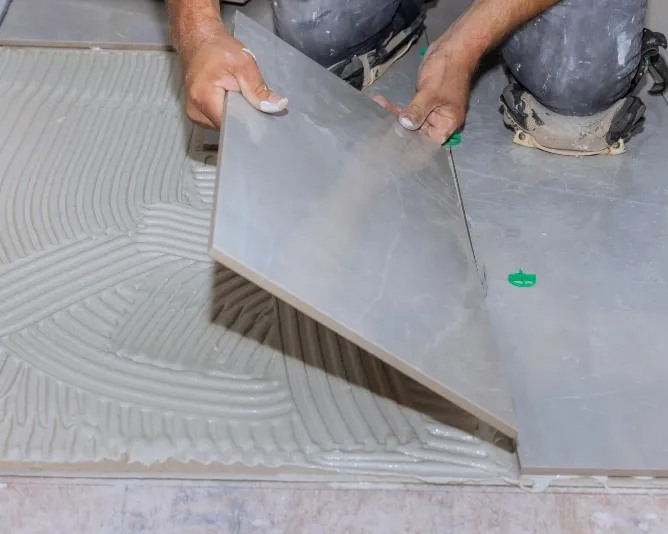Transform your porcelain tiles from vulnerable to invincible with expert sealing techniques that protect and preserve their beauty
Understanding Porcelain Tile Properties
Porcelain tiles are renowned for their exceptional durability and low maintenance requirements, primarily due to their manufacturing process. Created under extreme heat and pressure, these tiles typically have a porosity rate of less than 0.5%, making them naturally resistant to water, stains, and wear. This inherent density means that most porcelain tiles don’t actually require sealing. However, certain circumstances exist where sealing becomes beneficial. Polished porcelain tiles, for instance, can develop microscopic pores during the polishing process, potentially making them more susceptible to staining. Additionally, textured or unglazed porcelain tiles might benefit from sealing to enhance their protective properties.
Types of Sealers for Porcelain Tiles
- Penetrating Sealers: These sealers penetrate below the surface, providing invisible protection without altering the tile’s appearance. Ideal for unglazed porcelain and grout lines.
- Topical Sealers: Create a protective film on the surface, enhancing colour and providing a glossy or matte finish. Best suited for polished porcelain tiles.
- Specialized Porcelain Sealers: Products like SEAL-IT and GlazeGuard are specifically formulated with adhesion promoters to bond with dense porcelain surfaces.
- Grout Sealers: Essential for protecting the porous grout lines between tiles, available in both penetrating and membrane-forming varieties.
Pre-Sealing Preparation
Proper preparation is crucial for successful sealing. Begin by conducting a water test – sprinkle water on the tile surface; if it beads up, existing sealer is present and must be stripped. Thoroughly clean the surface using a pH-neutral cleaner specifically designed for porcelain tiles. Remove any old sealers using an appropriate stripper, following manufacturer guidelines carefully. The ambient temperature should be between 10-25°C with relative humidity below 70% for optimal results. Allow the surface to dry completely – typically 24-48 hours after cleaning – before proceeding with sealing.
Step-by-Step Sealing Process
The sealing process requires precision and patience for optimal results. Begin by working in manageable sections of approximately 1-2 square metres. Apply the sealer using a microfibre roller or applicator pad, maintaining a consistent, thin coat. Most porcelain sealers require 2-3 coats for maximum protection, with 30-60 minutes drying time between applications. Ensure even coverage and avoid pooling or streaking. After the final coat, allow 24 hours for light foot traffic and 72 hours for full cure. The average coverage rate is typically 15-20 square metres per litre, depending on tile porosity and sealer type.
Maintaining Sealed Porcelain Tiles
- Daily Cleaning: Use pH-neutral cleaners specifically formulated for sealed porcelain tiles
- Weekly Maintenance: Damp mop with warm water and gentle cleaner
- Quarterly Deep Clean: Professional-grade cleaning to remove built-up residue
- Annual Inspection: Check sealer integrity using the water bead test
- Resealing Schedule: Typically every 3-5 years, depending on traffic and wear
Professional Tips and Best Practices
Selecting the right products and tools is crucial for successful sealing. Choose polyurethane-based sealers with adhesion promoters for optimal bonding to porcelain surfaces. Always test products on a small, inconspicuous area first. Use microfibre applicators rather than traditional mops or brushes for even coverage. Common mistakes include over-application, insufficient drying time between coats, and using inappropriate cleaning products post-sealing. Consider professional application for large areas or when dealing with expensive designer tiles. Signs that professional intervention might be needed include uneven sealer appearance, persistent staining, or sealer delamination.
Conclusion
Proper sealing of porcelain tiles is an investment in their longevity and appearance. While not all porcelain tiles require sealing, understanding when and how to seal them can significantly enhance their performance and maintenance. Regular maintenance and periodic resealing ensure continued protection and beauty. Remember that the key to successful sealing lies in proper preparation, appropriate product selection, and careful application techniques. By following these guidelines, you can maintain your porcelain tiles’ pristine appearance for years to come, protecting your investment and ensuring lasting beauty in your space.
FAQ
What happens if you don’t seal porcelain tiles before?
Most porcelain tiles won’t need sealing, as they are naturally robust and offer water resistance. However, if you have polished porcelain or other porous tiles they must be sealed to stop water from entering and damaging the tile. Unsealed tiles can stain, and attract dust and dirt which can be difficult to clean.
Does sealing porcelain tile make it shiny?
Porcelain Tile Sealer For Patios creates a sheen on the surface of the tile once it is dry. It should be applied carefully in just one thin coat. We recommend using a microfibre flat mop or a microfibre cloth soaked in the sealer.
How long should porcelain tile last?
Tile types and their lifespans You can expect a lifespan of 50 years or more from high-quality porcelain tile.
Is it worth sealing porcelain tiles?
As porcelain is a durable and hard-wearing material, it doesn’t need to be sealed. Regardless of whether you opt for our Project or Luxury range, our porcelain paving has a low porosity, which means that natural nuisances such as algae and moss are less able to gain a foothold in the pores of the material.
Can water seep through porcelain tile?
Unlike many other materials, porcelain tiles do not require additional waterproofing treatments. Their inherent density and hardness prevent water from seeping through, reducing the risk of mould, mildew, and water damage.
Sources
[1] https://www.youtube.com/watch?v=6yORL88SWzQ
[2] https://www.covertecproducts.com/does-porcelain-tile-need-to-be-sealed/
[3] https://www.covertecproducts.com/everything-you-need-to-know-about-porcelain-tile-sealer-what-sealers-work-on-porcelain/



